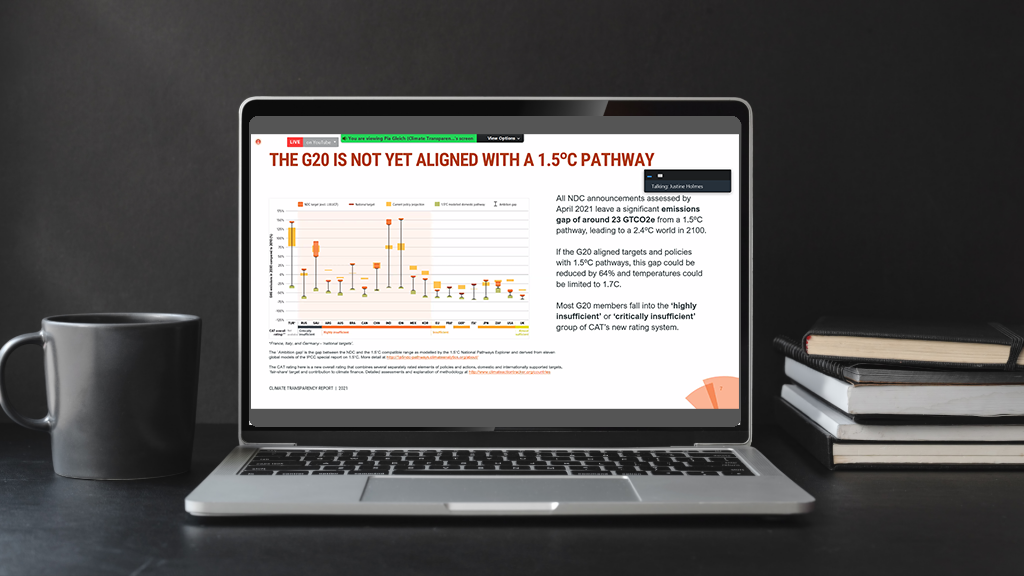2021 is marked as the year of the rebound of emission especially in the G20 countries as the economic and social activity is restarting. Previously, emission in the G20 recorded a decrease due to government regulation to overcome the Covid-19 outbreak. Although 14 G20 states have proposed net zero targets which covers around 61 percent of GHG emissions in the world, it is still not aligning with the 1.5 degree Celsius pathway. Climate Transparency Report 2021 finds that some countries such as Argentina, China, India, and Indonesia are projected to exceed their 2019 emissions level. As the window of opportunity to comply with the Paris Agreement is getting narrow, the G20 countries need to raise their climate ambition higher and to move together fighting the climate crisis.
The Climate Transparency Report, an annual report reviewing the climate ambition and policy of the G20 countries, stating several key findings for the 2021 report that was launched on October 14, 2021. They are:
- Raised ambitions are not complying with the Paris Agreement yet
In the year of 2021, 14 G20 countries are updating their climate ambition and proposing a net-zero target. 13 updated NDC were submitted to UNFCCC and 6 of those countries i.e Argentina, Canada, EU (including France, Germany and Italy), South Africa, the UK and The US increased their NDC target, and that is good news. Unfortunately, all of them are not enough yet to comply with the 1.5 degree plan. By following the current ambition the global temperature will still rise up to 2.4 degrees. A more holistic and communal effort is definitely needed to keep the global temperature in the 1.5 degrees level.
“If the G20 were to align its targets and policies with one and a half degree pathways and implement those policies, the global emissions gap of around 23 gigatons can be reduced significantly,” said Justine Holmes, Solutions For Our Climate
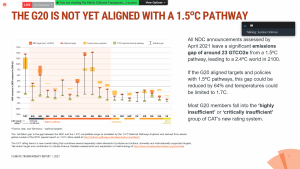
- Fossil fuel subsidy is still remaining
During the economic recovery, most of the G20 countries are injecting subsidies for the fossil fuel sector. In fact, the amount of fossil fuel subsidies are way bigger than the green recovery package prepared by the G20 governments. From January 2020 to August 2021 the G20 committed USD 298 billion to subsidise the fossil fuel industry. USD 248 billion of the USD 298 billion has gone without the ‘green pact’ attached. Meaning the fossil fuel industry has no obligation to for instance lowering their emissions, or other deals to consider the environment or climate change situation.
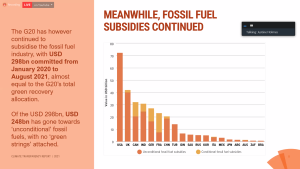
- Emission is rebounding
As the economic activity is restarting, emission in the G20 country is rebounding again. Total emissions in 2020 were decreased up to 6% and it is projected to rise 4% this year. Countries like Argentina, China, India, and Indonesia are even projected to exceed the 2019 emissions level. This is actually predicted, that the decreased emissions in 2020 are closely related to the social activity restriction during the pandemic outbreak.
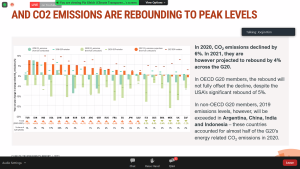
- It is urgent to phase out coal power plant
Coal-fired power plants are known for their intense carbon emissions. As of 2020, China (163 GW), India (21 GW), Indonesia (18 GW), and Turkey (12 GW) still have coal power plants on the pipeline. All G20 members will need to phase out coal between 2030 – 2040 to limit global average temperature to 1.5 degrees Celsius.
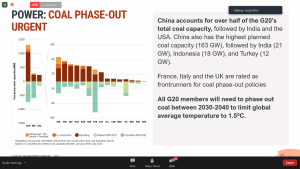
Fabby Tumiwa, Executive Director of IESR, during his presentation explained that currently Indonesia is still dominated by coal in its energy mix. In October, the Indonesian government issued a new RUPTL which accommodates more renewables share rather than thermal power plan, plus PLN plan to decommission the supercritical coal power plant starting from 2030.
“Recently we are also discussing the possibility to do an early coal moratorium before 2025 but it’s still the plan, not yet settled and we still provide subsidies on fossil fuel. Phasing out fossil fuel subsidies will help to expedite the energy transitions,” he concluded.

